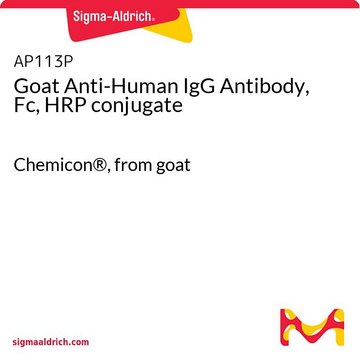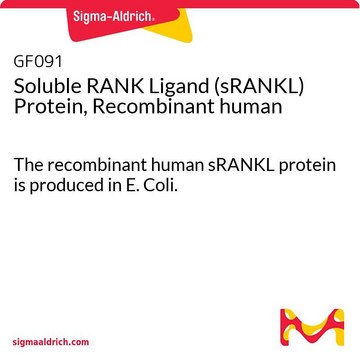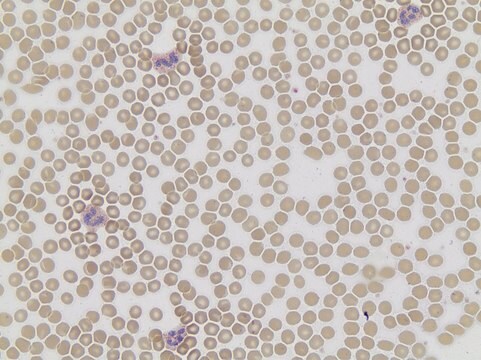おすすめの製品
由来生物
human
リコンビナント
expressed in E. coli
アッセイ
≥98% (HPLC)
≥98% (SDS-PAGE)
形状
lyophilized
有効性
10.0-25.0 ng/mL ED50
分子量
20.0 kDa
包装
pkg of 10 μg
テクニック
cell culture | mammalian: suitable
不純物
<0.1 EU/μg endotoxin, tested
色
white
適合性
suitable for molecular biology
UniProtアクセッション番号
輸送温度
wet ice
保管温度
−20°C
遺伝子情報
human ... TNFSF11(8600)
詳細
Research area: Cell signaling. TRANCE (TNF-related activation-induced cytokine), also known as sRANKL (soluble receptor activator of nuclear factor K-B ligand), is encoded by the gene mapped to human chromosome 13q14.11. sRANKL and RANK (receptor activator of nuclear factors-KB) are members of the tumor necrosis factor (TNF) superfamily of ligands and receptors that play an important role in the regulation of specific immunity and bone turnover. RANKL is expressed in a variety of cells including osteoblasts, fibroblasts, activated T-cells and bone marrow stromal cells. Recombinant human sRANKL is a 20kDa polypeptide comprising the TNF homologous region of RANKL (176 amino acid residues).
アプリケーション
sRANKL has been used to initiate differentiation of osteoclasts.
生物化学的/生理学的作用
RANKL (receptor activator of nuclear factor K-B ligand) is a potent stimulator of bone resorption. Aberrations in RANK (Receptor activator of nuclear factors-κB) and RANKL (Receptor activator of nuclear factors-κB ligand) genes have been associated with osteoporosis, chronic inflammatory arthritis, the osteolytic bony metastasis of malignancies, and reduced bone mineral density in patients with ankylosing spondylitis. RANK (receptor) was originally identified as a dendritic-cell-membrane protein, which by interacting with RANKL augments the ability of dendritic cells to stimulate naïve T-cell proliferation in a mixed lymphocyte reaction, to promote the survival of RANK+ T cells, and to regulate T-cell-dependent immune response. RANKL is also capable of interacting with a decoy receptor called OPG (osteoprotegerin). Binding of soluble OPG to sRANKL inhibits osteoclastogenesis by interrupting the signaling between stromal cells and osteoclastic progenitor cells, thereby leading to excess accumulation of bone and cartilage.
シーケンス
MEKAMVDGSW LDLAKRSKLE AQPFAHLTIN ATDIPSGSHK VSLSSWYHDR GWAKISNMTF SNGKLIVNQD GFYYLYANIC FRHHETSGDL ATEYLQLMVY VTKTSIKIPS SHTLMKGGST KYWSGNSEFH FYSINVGGFF KLRSGEEISI EVSNPSLLDP DQDATYFGAF KVRDID
物理的形状
凍結乾燥品(5 mMリン酸ナトリウム、pH 7.6 + 75 mM NaCl)。
再構成
バイアルは、開封前に遠心してください。0.1~1.0 mg/mLの濃度となるよう水で再構成してください。ボルテックスは行わないでください。この溶液は2~8°Cで1週間まで保存できます。長期保存の際は、キャリアタンパク質(0.1% BSAなど)を含有するバッファーで希釈し、1回使用量ごとに分けて-20~-80°Cで保存することをお勧めします。
保管分類コード
11 - Combustible Solids
WGK
WGK 3
引火点(°F)
Not applicable
引火点(℃)
Not applicable
適用法令
試験研究用途を考慮した関連法令を主に挙げております。化学物質以外については、一部の情報のみ提供しています。 製品を安全かつ合法的に使用することは、使用者の義務です。最新情報により修正される場合があります。WEBの反映には時間を要することがあるため、適宜SDSをご参照ください。
Jan Code
SRP3161-10UG:
試験成績書(COA)
製品のロット番号・バッチ番号を入力して、試験成績書(COA) を検索できます。ロット番号・バッチ番号は、製品ラベルに「Lot」または「Batch」に続いて記載されています。
Cost-effective analysis of candidate genes using htSNPs: a staged approach.
Lowe C E, et al.
Genes and Immunity, 5(4), 301-301 (2004)
The role of osteoprotegerin and receptor activator of nuclear factor KB ligand in the pathogenesis and treatment of rheumatoid arthritis.
Hofbauer L C and Armin E H
Arthritis & Rheumatology (Hoboken, N.J.), 44(2), 253-259 (2001)
Alendronate Functionalized Mesoporous Bioactive Glass Nanospheres.
Boanini E
Materials, 9, 135-135 (2016)
Elevated serum levels of soluble receptor activator of nuclear factors-kappaB ligand (sRANKL) and reduced bone mineral density in patients with ankylosing spondylitis (AS).
Kim HR
Rheumatology (Oxford, England), 45, 1197-1200 (2006)
Interactions of tumor necrosis factor (TNF) and TNF receptor family members in the mouse and human.
Bossen C, et al.
The Journal of Biological Chemistry, 281(20), 13964-13971 (2006)
ライフサイエンス、有機合成、材料科学、クロマトグラフィー、分析など、あらゆる分野の研究に経験のあるメンバーがおります。.
製品に関するお問い合わせはこちら(テクニカルサービス)








